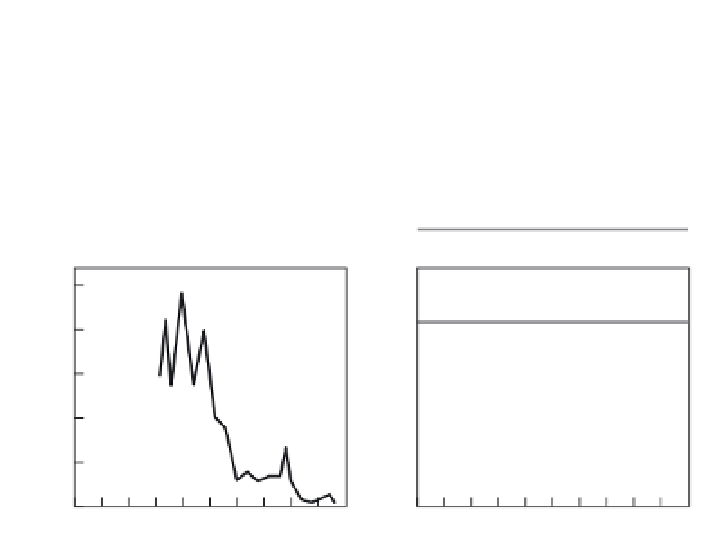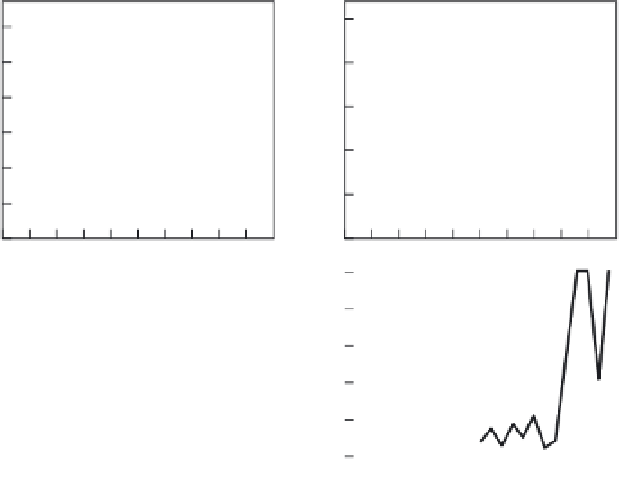Environmental Engineering Reference
In-Depth Information
(a)
(b)
0.5
3.0
2.5
0.4
2.0
0.3
1.5
0.2
1.0
0.1
0.5
Fig. 12.6
Long-term monitoring of
the effects of various P-reduction
measures in the shallow Dutch
Lake Veluwe almost immediately
after the lake's formation. Note
the marked increase in Secchi-disc
transparency in the mid-1990s.
The fluctuations in transparency,
especially the decrease during 2001,
are caused by wet winter periods.
Courtesy of M.L. Meijer
et al.
,
unpublished results.
0.0
0.0
250
(c)
1.2
(d)
1.0
200
0.8
150
0.6
100
0.4
50
0.2
0
0.0
1960
1970
1980
1990
2000
1960
1970
1980
1990
2000
led to no marked changes in water quality, nor
reduction in the cyanobacterial dominance (Heaney
et al.
1992).
In the Netherlands, P loading and total P concen-
tration in Lake Veluwe (one of the Border Lakes
formed from Lake IJssel during a land-reclamation
programme) have been monitored since the lake's
formation in 1957. The different P-reduction measures
in the course of years have led to marked decreases
in the P and chlorophyll concentrations, causing
marked increase in water transparency (Fig. 12.6). In
another more elaborate study, P in the inflow water
to the hypertrophic Loosdrecht Lakes, in the Nether-
lands, was substantially reduced in 1984 by reducing
P loading via the inlet water by different control meas-
ures, and its effects on different parameters including
P dynamics in these lakes were monitored (see papers
in van Liere & Gulati 1992). The water quality did not
improve during the first decade or so, which could be
attributed to increased P retention in the sediments,
retarding the lakes' response. Similarly, Jeppesen
et al.
(1991) observed no response in Danish lakes to a 70%
or greater reduction of P in the inflows. Cullen and
Forsberg (1988) distinguished three types of response
in chlorophyll and algal biomass based on data from
43 lakes:
1
in 15 lakes there was an improvement in water qual-
ity from hypertrophic to eutrophic to mesotrophic;
2
in nine lakes there was insufficient reduction of algal
biomass to change the trophic status discernibly;
3
in 19 lakes there was little or no reduction algal bio-
mass, but nuisance species may have been reduced.
Phosphorus from the external inputs may also be
removed by passing P-rich effluents into treatment
ponds, where much of the element is adsorbed on to
sediments and settles. Also, P released due to lysis
and death of algal blooms will be taken up by the
sediment. Regular harvesting of aquatic vegetation
(e.g. duckweeds,
Lemna
; water fern,
Azolla
; and other
floating forms) can remove P (e.g. Viessman &
Hammer 1993). For a reduction in non-point nutrient
loading, agricultural farming practices in a lake's
catchment area need to be altered radically by pre-
vention of erosion, rationalizing the frequency and
timing of fertilizer applications, minimizing P use and
reducing the amount of fertilizer P imported to the
watershed. In addition, more pasture land needs to be
created and buffer strips should be planted between
farmland and watercourses, as recommended for pro-
tecting the deteriorating Slapton Ley, a nature reserve
in south-west England (Wilson
et al.
1993).




